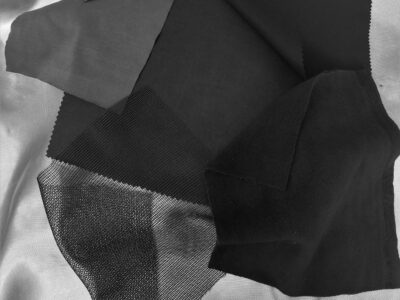EeonTex™ Conductive Textiles: Innovating Electrical Solutions
EeonTex™ conductive textiles represent a groundbreaking advancement in materials technology. These exceptional fabrics are the result of cutting-edge proprietary coating techniques. Within each fabric or yarn, individual fibers receive a thorough and consistent application of various nonmetallic, conductive formulations. Whether your needs require woven, knitted, or nonwoven textiles, be they synthetic or natural, our aqueous-based processes can coat a wide range of substrates, including polyester, nylon, glass, spandex, and aramid. Our specialized coatings endow substrates with electrical conductivity and rich, dark color while minimally impacting their original strength, drape, flexibility, stretch, and porosity. Moreover, our fabrics can be customized to meet specific electrical resistance requirements for various applications. We also offer secondary coatings to enhance environmental protection and flame resistance.
EeonTex fabrics exhibit surface resistivities ranging from approximately 10 ohm/sq to 10M ohm/sq. Many of our high-resistance fabrics display excellent piezoresistive properties, making them ideal for pressure and strain-sensing applications. Our thinner fabrics are adept at absorbing up to 50% of incoming microwave radiation, while thicker versions, often referred to as felts, excel at absorbing over 80%. Our fabrics exhibit a predominantly resistive, broad-spectrum response to radar signals. One of the standout features of EeonTex fabrics is their ability to instantaneously dissipate static charge, regardless of humidity levels. Integration into composite laminates is seamless, typically resulting in strong resin-to-textile adhesion. Importantly, our coatings are nonmetallic, nontoxic, and fully RoHS compliant.
EeonTex fabrics have found diverse applications, including:
- Heating Elements: Our fabrics are used to create efficient and reliable heating elements.
- Low Radar Cross Section (RCS) Structures and Gaskets: EeonTex fabrics contribute to reduced radar cross-section and effective gasket solutions.
- EMI Suppression: For electromagnetic interference suppression, our fabrics provide an optimal solution.
- Artificial Horizon/Radar Barriers: These textiles are instrumental in creating artificial horizon and radar barriers.
- RF Curtains: EeonTex fabrics are employed in RF curtains to manage radio frequency interference.
- Antenna Side Lobe Suppression: For antenna performance enhancement, our fabrics are used to suppress side lobes.
- Impedance Matching: Achieve precise impedance matching with our tailored fabrics.
- Biometric Pressure Mapping Sensors: EeonTex fabrics are integral to biometric pressure mapping sensor technology.
- Static Dissipation: Instantaneous static charge dissipation is a key benefit for various applications.
- Touch-Screen Compatible Gloves: These textiles are used to create touch-screen compatible gloves, combining functionality and comfort.
Incorporate EeonTex™ conductive textiles into your projects for cutting-edge performance, reliability, and versatility. Experience the future of materials technology today.
Contact Us for more information.

